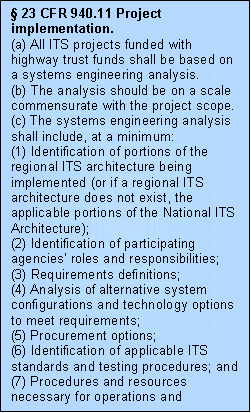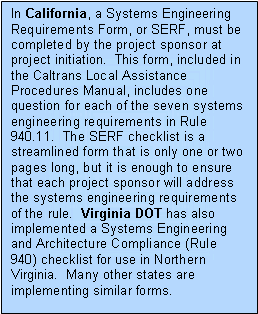Systems Engineering for Intelligent Transportation Systems
Although ITS projects come in many shapes and sizes, they all use technology (computers, communications, sensors, etc.) and frequently include the exchange of information, either within a system or between systems. The technology and integration that sets ITS projects apart also creates challenges for the ITS project manager. What every ITS project manager wants is a successful result at the end of the project, with "success" measured by:
Systems engineering reduces the risk of schedule and cost overruns and increases the likelihood that the implementation will meet the user's needs. Other benefits include:
These assertions have been supported by several studies that have shown that good systems engineering results in better cost and schedule performance. Studies have been performed by the International Council of Systems Engineering (INCOSE)1, Boeing2, and IBM3, among others. Figure 1 shows the results of an INCOSE study that collected both planned and actual project and systems engineering cost data for 44 projects. The survey indicated that investing in systems engineering did improve project cost performance. The responses indicated a 50% overrun on average without systems engineering and a clear trend toward better cost performance results with systems engineering.
Figure 1: Systems Engineering Improves Project Cost Performance
 US
DOT recognized the potential benefit of the systems engineering approach for
ITS projects and included requirements for a systems engineering analysis in
the FHWA Rule/FTA Policy that was enacted on January 8, 2001. The Rule/Policy
requires a systems engineering analysis to be performed for ITS projects that
use funds from the Highway Trust Fund, including the Mass Transit Account. As
shown in an excerpt from the Rule in Figure 2, the Rule/Policy actually
specifies seven requirements that the systems engineering analysis must include
at a minimum.
US
DOT recognized the potential benefit of the systems engineering approach for
ITS projects and included requirements for a systems engineering analysis in
the FHWA Rule/FTA Policy that was enacted on January 8, 2001. The Rule/Policy
requires a systems engineering analysis to be performed for ITS projects that
use funds from the Highway Trust Fund, including the Mass Transit Account. As
shown in an excerpt from the Rule in Figure 2, the Rule/Policy actually
specifies seven requirements that the systems engineering analysis must include
at a minimum.

Figure 2: FHWA/FTA Systems Engineering Analysis Requirements
 The
Rule/Policy allows each project sponsor to use a systems engineering approach
that is tailored to fit the needs of each ITS project. As you will see in the
following chapters, the systems engineering approach is actually broader than
the seven specific requirements identified in the Rule/Policy. If you
implement a good systems engineering process, you will meet or exceed the
specific systems engineering analysis requirements identified in the Rule/Policy.
The
Rule/Policy allows each project sponsor to use a systems engineering approach
that is tailored to fit the needs of each ITS project. As you will see in the
following chapters, the systems engineering approach is actually broader than
the seven specific requirements identified in the Rule/Policy. If you
implement a good systems engineering process, you will meet or exceed the
specific systems engineering analysis requirements identified in the Rule/Policy.
 The FHWA
Division and FTA Regional Offices determine how the systems engineering
analysis requirements in the Rule/Policy should be applied to ITS projects in
each region and how compliance should be demonstrated by each project sponsor.
Federal oversight is provided based on oversight requirements defined in the
stewardship agreements with each state. Several states have established
checklists that prompt project sponsors to consider the systems engineering
analysis requirements as part of the project development process, as shown in Figure
3.4
Contact the ITS specialist in your FHWA Division Office or FTA Regional Office
for more information.
The FHWA
Division and FTA Regional Offices determine how the systems engineering
analysis requirements in the Rule/Policy should be applied to ITS projects in
each region and how compliance should be demonstrated by each project sponsor.
Federal oversight is provided based on oversight requirements defined in the
stewardship agreements with each state. Several states have established
checklists that prompt project sponsors to consider the systems engineering
analysis requirements as part of the project development process, as shown in Figure
3.4
Contact the ITS specialist in your FHWA Division Office or FTA Regional Office
for more information.

Figure 3: Examples of Systems Engineering Analysis Requirements Checklist
Note that each organization may establish its own systems engineering process requirements that satisfy the requirements of the Rule/Policy, as Florida DOT did with its Systems Engineering Management Plan (see http://www.floridaits.com/SysEng.html).
TOC Previous Page Next Page